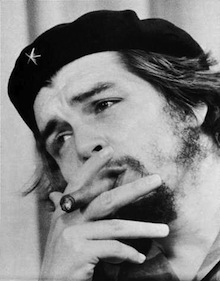Yesterday, a federal judge slapped down the Food & Drug Administration’s new tobacco warning labels as a violation of the Constitution’s free-speech protections. The legal challenge was brought by five tobacco companies, including some of the largest cigarette makers.
 The new FDA labels, which take up half of the surface area on a pack of cigarettes, were scheduled to debut in September. Proposed last year, they were full color photos (including images of a cadaver with a sewn-up chest, diseased lungs and gums, and cigarette smoke drifting around an infant) accompanied by a “Quit Now” toll-free phone number.
The new FDA labels, which take up half of the surface area on a pack of cigarettes, were scheduled to debut in September. Proposed last year, they were full color photos (including images of a cadaver with a sewn-up chest, diseased lungs and gums, and cigarette smoke drifting around an infant) accompanied by a “Quit Now” toll-free phone number.
U.S. District Judge Richard Leon’s ruling sharply criticized the FDA for misrepresenting the labels. In a key footnote, he wrote, “Although the FDA conveniently refers to these graphic images as ‘graphic warnings,’ characterizing these graphic images as ‘warnings’ is inaccurate and unfair as they are more about shocking and repelling than warning.”
Later in the 19-page decision, Leon wrote, “The graphic images here were neither designed to protect the consumer from confusion or deception, nor to increase consumer awareness of smoking risks; rather, they were crafted to evoke a strong emotional response calculated to provoke the viewer to quit or never start smoking.”
In concluding that the labels were a violation of the First Amendment, Leon wrote, “The government has failed to carry both its burden of demonstrating a compelling interest and its burden of demonstrating that the rule is narrowly tailored to achieve a constitutionally permissible form of compelled commercial speech.”
Analysis
While not specifically related to cigars, this ruling has significant implications for all FDA regulation of tobacco, showing that there are limits to the government’s seemingly endless war on tobacco.
Judge Leon’s frequent criticism of FDA misrepresentations is particularity important, finally putting the brakes on the anti-tobacco movement’s attempt to play fast and loose with the facts. Critically, it sets a precedent that anti-tobacco regulations must be fact-based, and can’t merely be designed to oppose smoking.
Left unsaid was the hypocrisy of how anti-tobacco advocates frequently point back to supposed scientific misrepresentations of tobacco companies many decades ago, but now are the ones who frequently rely on suspect scientific conclusions and dubious logic. For example, the FDA’s own study released in October 2010 found that although the labels may stir the emotions of smokers, they might not cause smokers to quit.
For cigars, whose often ornate and decorative packaging is steeped in tradition, the limits on labels is even more important than it is for cigarettes. And with the FDA currently moving to regulate cigars like cigarettes, this ruling could be critical to limiting the damage done to to cigars until H.R. 1639 becomes law.
–Patrick S
photo credit: FDA


 Are Cubans really the best?
Are Cubans really the best?
 Para Ti is the project of Pete Johnson’s friend,
Para Ti is the project of Pete Johnson’s friend, 

 The
The 
 Patrick Ashby
Co-Founder & Editor in Chief
Patrick Ashby
Co-Founder & Editor in Chief Patrick Semmens
Co-Founder & Publisher
Patrick Semmens
Co-Founder & Publisher George Edmonson
Tampa Bureau Chief
George Edmonson
Tampa Bureau Chief